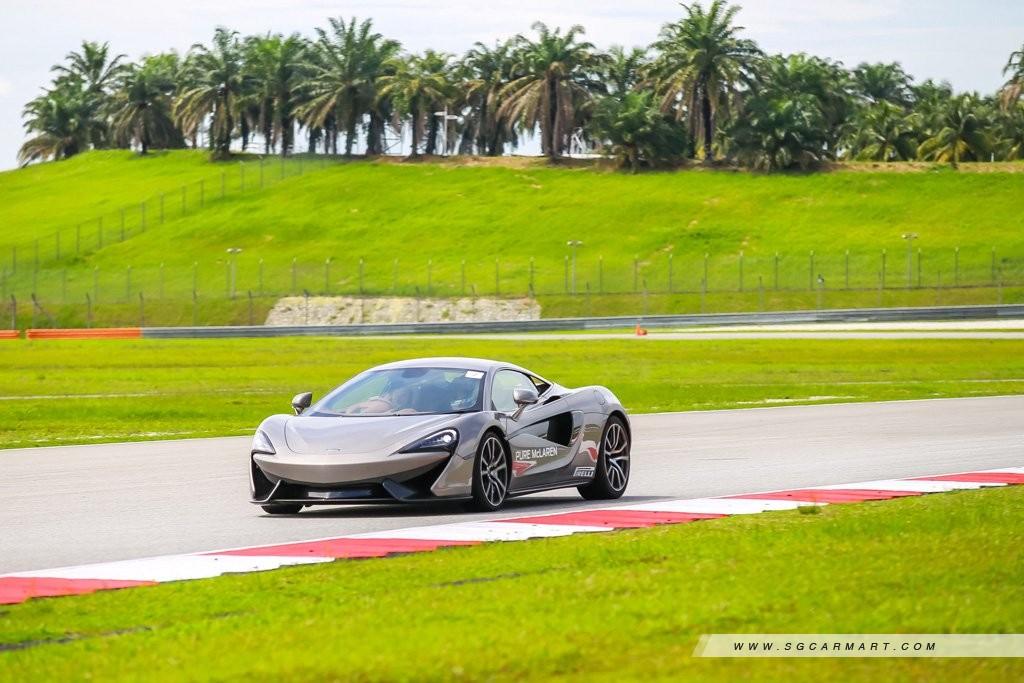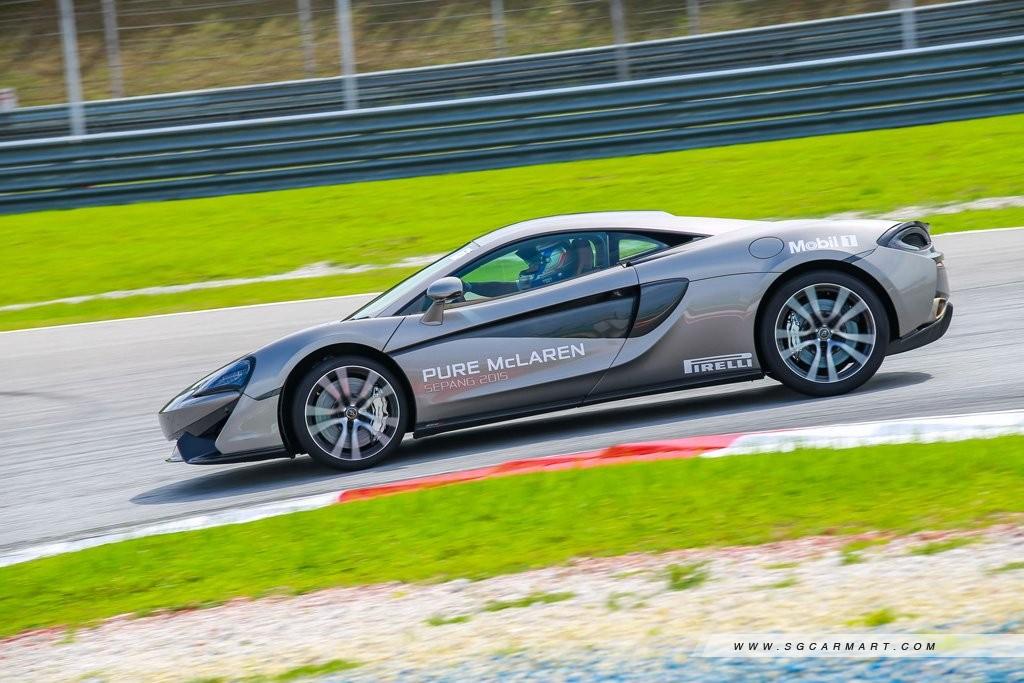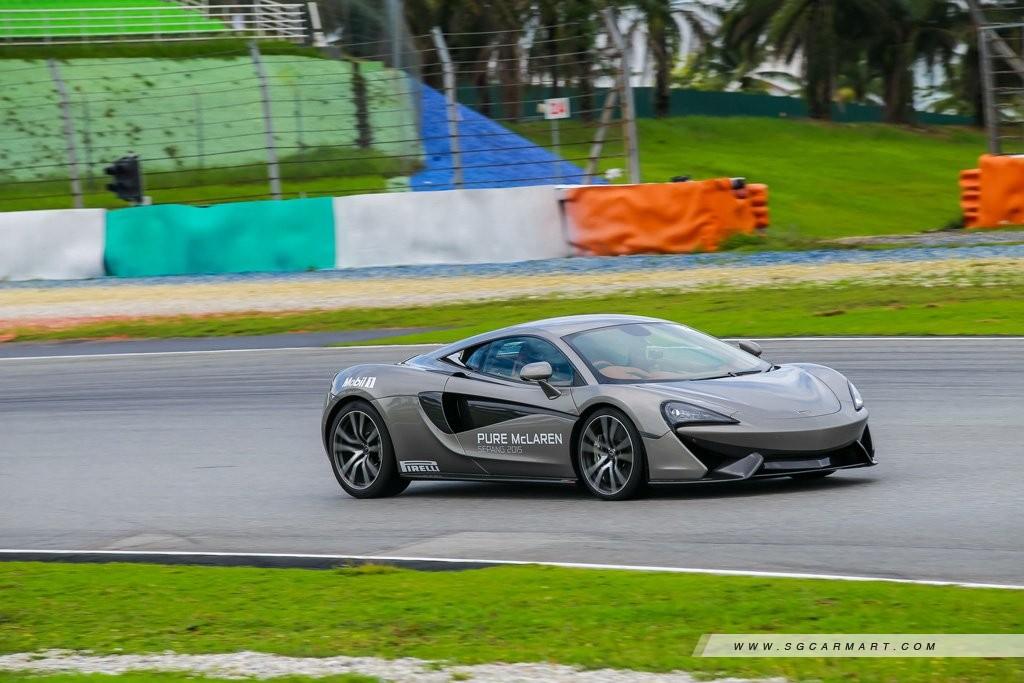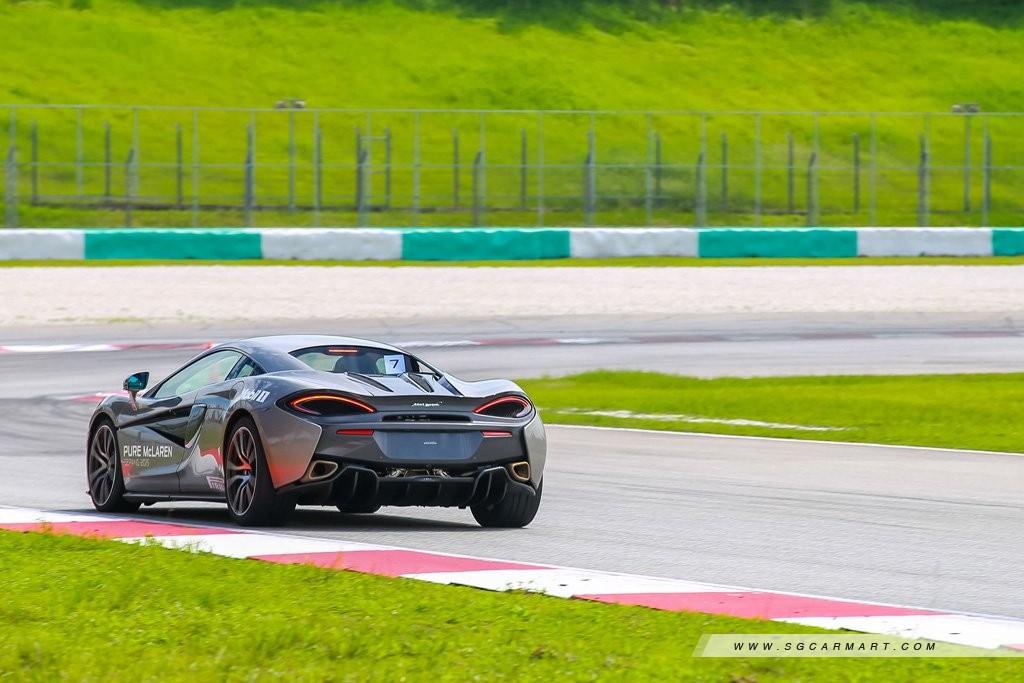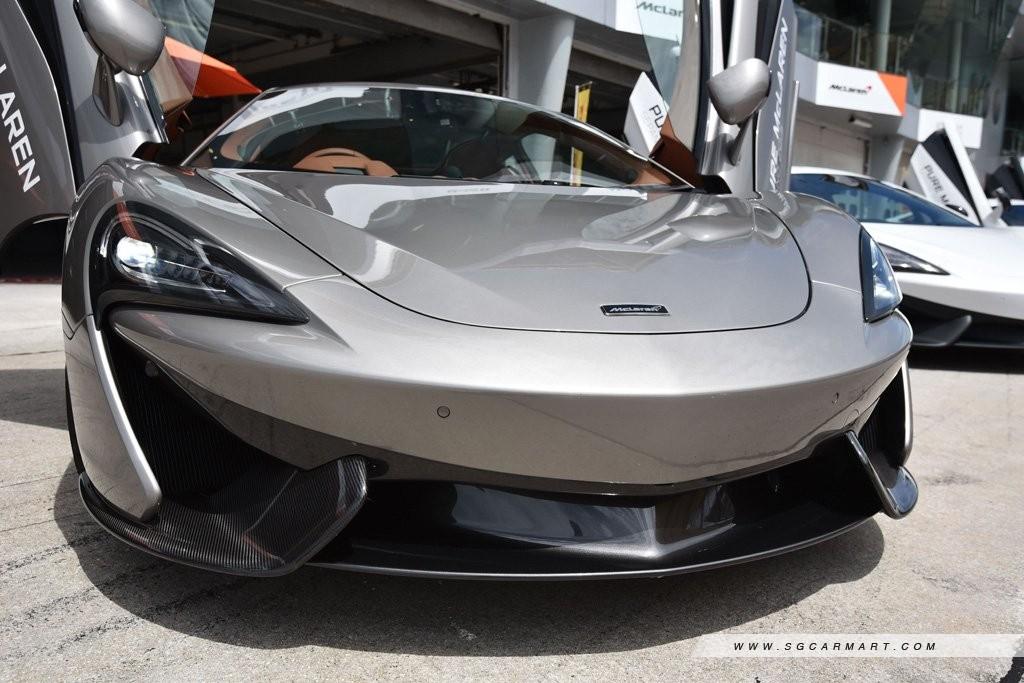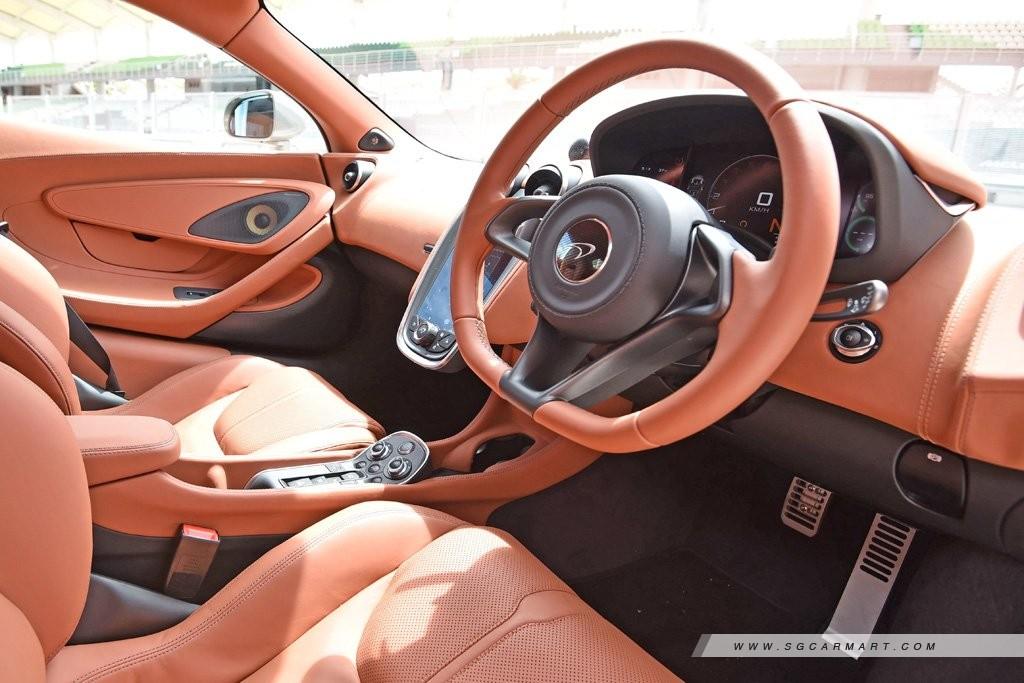McLaren 570S 3.8 (A) First Drive Review
06 Jan 2016|11,663 views
In this new world order where sports cars and supercars rub shoulders, McLaren has introduced its baby 570S into that ambiguous area, seeking to carve a niche for itself. But where exactly does the car fit in the British carmaker's lineup?
Unveiled at the 2015 New York Motor show, the 570S is the first car in the Sports Series range and completes the three-tier model lineup, with the Super Series 650S and 675LT, and the P1 hypercar in the top-of-the-line Ultimate Series.
The coupe shares its DNA with both the 650S and P1, while also using a range of racing technologies that already debuted in previous models. It is part of McLaren's recently announced plans to expand globally, and by the looks of things, this new strategy is off to a great start.
Exterior
Although there's clearly a family face and a commonality in the shape of the glasshouse, virtually everything else about the 570S is different from its siblings - and the rear is where this car is unique.
 |
Instead of an active rear wing as seen on the 650S, McLaren opted for a fixed rear spoiler lip on this car. The full width carbon fibre rear diffuser is also among the most beautiful we have seen and this helps to make the car very appealing.
Overall, it's a slightly more cohesive design than the 650S', with interesting details like the central door sections, or what McLaren calls 'tendons', that appear to float in mid air.
Despite its positioning as the 'baby' McLaren, the 570S is actually 18mm longer, 2mm wider but 1mm lower than the 650S. However, thanks to clever packaging by designers, the car looks smaller and more compact than its elder brother.
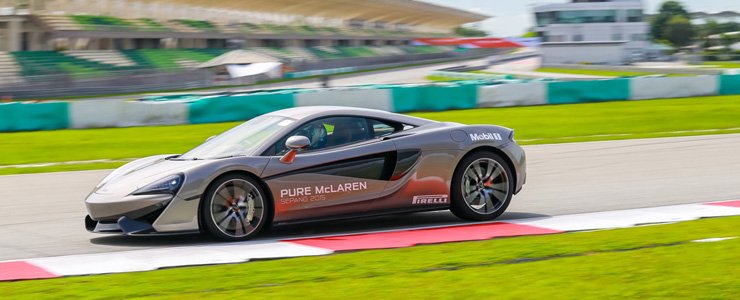 |
Interior
For the 570S, McLaren softened things up a little to make the Sports Series model a more practical, everyday car. In the most visible nod to civility, the car's dihedral doors have been reworked to ease entry and egress - which is considerate, given the origami-like human body folding technique required to enter a 650S.
The door sills are also narrower and lower by some 85mm, so getting in and out becomes much more convenient. It's not as easy as jumping into a conventionally doored sports car, but the process is less awkward than it was with the old 12C or the 650S.
There's a little bit more friendliness to this cabin too, with bottle-sized cubby holes in the doors, a larger central storage area, and McLaren's inaugural use of vanity mirrors. More cargo can also be tucked under the bonnet in the 150-litre boot, which is six litres more than in the 650S.
Both the TFT instrument panel and the floating 7.0-inch IRIS touchscreen infotainment display are intuitive and clear, while various shades of hand-stitched leather and Alcantara coupled with satin chrome and carbon fibre trims provide just the right level of sensuality.
Knobs and switches actuate with reassuring clicks, and even the turn signal stalks - ergonomically curved slivers of aluminium - deliver a sense of tactile satisfaction.
 |
The Drive
The 570S is powered by a slightly dialed-back version of the same 3.8-litre twin-turbo V8 that has 30 percent new components. With it delivering 562bhp and 600Nm of torque to the rear wheels, the car rockets from 0 to 100km/h in 3.2 seconds and reaches a very McLaren-like top speed of 328km/h.
The car also shares its seven-speed dual-clutch gearbox with the larger 650S, which helps the well-mannered 570S hold its own on the track.
You can tell a lot about a performance car within initial moments of acceleration, and the first few hundred metres of tarmac speak volumes of the 570S's demeanour.
The throttle response is pretty crisp, but at low revs, there are also occasions that leave you waiting for meaningful thrust to arrive. That said, before you know it, you hear a whoosh as the boost builds, catapulting the car down the straight at a ridiculous rate.
At the same time, the optional sport exhaust makes the car's intentions audibly clear, both inside the cabin and to anyone outside. On idle and startup, it is clearly not as loud as the 650S but under hard acceleration it is able to give many sports cars in this segment a run for their money.
More than any other McLaren, this one was built to be driven on a daily basis. This is aided by adaptable suspension - featuring adaptive dampers, front and rear anti-rollbars and double wishbones.
It's a firm car as standard but the dampers offer supreme control, and at speed there's a gentle fluidity to the way it moves. Slicing through the curves of the Sepang International Circuit, the 570S is wildly, wonderfully alive, the weight of its steering a palpable delight and the crisp clicks of the paddle shifters as pleasurable as the way the car behaves.
Conclusion
Softer-edged but better rounded in its overall skill set, this baby McLaren brings an element of supercar occasion to a sports car segment that its rivals may find it hard to level with. Moreover, its excellent accessibility makes it an ideal daily driver.
Far from being a lesser McLaren, the 570S is one mighty machine.
In this new world order where sports cars and supercars rub shoulders, McLaren has introduced its baby 570S into that ambiguous area, seeking to carve a niche for itself. But where exactly does the car fit in the British carmaker's lineup?
Unveiled at the 2015 New York Motor show, the 570S is the first car in the Sports Series range and completes the three-tier model lineup, with the Super Series 650S and 675LT, and the P1 hypercar in the top-of-the-line Ultimate Series.
The coupe shares its DNA with both the 650S and P1, while also using a range of racing technologies that already debuted in previous models. It is part of McLaren's recently announced plans to expand globally, and by the looks of things, this new strategy is off to a great start.
Exterior
Although there's clearly a family face and a commonality in the shape of the glasshouse, virtually everything else about the 570S is different from its siblings - and the rear is where this car is unique.
Instead of an active rear wing as seen on the 650S, McLaren opted for a fixed rear spoiler lip on this car. The full width carbon fibre rear diffuser is also among the most beautiful we have seen and this helps to make the car very appealing.
Overall, it's a slightly more cohesive design than the 650S', with interesting details like the central door sections, or what McLaren calls 'tendons', that appear to float in mid air.
Despite its positioning as the 'baby' McLaren, the 570S is actually 18mm longer, 2mm wider but 1mm lower than the 650S. However, thanks to clever packaging by designers, the car looks smaller and more compact than its elder brother.
Interior
For the 570S, McLaren softened things up a little to make the Sports Series model a more practical, everyday car. In the most visible nod to civility, the car's dihedral doors have been reworked to ease entry and egress - which is considerate, given the origami-like human body folding technique required to enter a 650S.
The door sills are also narrower and lower by some 85mm, so getting in and out becomes much more convenient. It's not as easy as jumping into a conventionally doored sports car, but the process is less awkward than it was with the old 12C or the 650S.
For the 570S, McLaren softened things up a little to make the Sports Series model a more practical, everyday car. In the most visible nod to civility, the car's dihedral doors have been reworked to ease entry and egress - which is considerate, given the origami-like human body folding technique required to enter a 650S.
The door sills are also narrower and lower by some 85mm, so getting in and out becomes much more convenient. It's not as easy as jumping into a conventionally doored sports car, but the process is less awkward than it was with the old 12C or the 650S.
There's a little bit more friendliness to this cabin too, with bottle-sized cubby holes in the doors, a larger central storage area, and McLaren's inaugural use of vanity mirrors. More cargo can also be tucked under the bonnet in the 150-litre boot, which is six litres more than in the 650S.
Both the TFT instrument panel and the floating 7.0-inch IRIS touchscreen infotainment display are intuitive and clear, while various shades of hand-stitched leather and Alcantara coupled with satin chrome and carbon fibre trims provide just the right level of sensuality.
Knobs and switches actuate with reassuring clicks, and even the turn signal stalks - ergonomically curved slivers of aluminium - deliver a sense of tactile satisfaction.
The Drive
The 570S is powered by a slightly dialed-back version of the same 3.8-litre twin-turbo V8 that has 30 percent new components. With it delivering 562bhp and 600Nm of torque to the rear wheels, the car rockets from 0 to 100km/h in 3.2 seconds and reaches a very McLaren-like top speed of 328km/h.
The car also shares its seven-speed dual-clutch gearbox with the larger 650S, which helps the well-mannered 570S hold its own on the track.
You can tell a lot about a performance car within initial moments of acceleration, and the first few hundred metres of tarmac speak volumes of the 570S's demeanour.
The throttle response is pretty crisp, but at low revs, there are also occasions that leave you waiting for meaningful thrust to arrive. That said, before you know it, you hear a whoosh as the boost builds, catapulting the car down the straight at a ridiculous rate.
At the same time, the optional sport exhaust makes the car's intentions audibly clear, both inside the cabin and to anyone outside. On idle and startup, it is clearly not as loud as the 650S but under hard acceleration it is able to give many sports cars in this segment a run for their money.
The 570S is powered by a slightly dialed-back version of the same 3.8-litre twin-turbo V8 that has 30 percent new components. With it delivering 562bhp and 600Nm of torque to the rear wheels, the car rockets from 0 to 100km/h in 3.2 seconds and reaches a very McLaren-like top speed of 328km/h.
The car also shares its seven-speed dual-clutch gearbox with the larger 650S, which helps the well-mannered 570S hold its own on the track.
You can tell a lot about a performance car within initial moments of acceleration, and the first few hundred metres of tarmac speak volumes of the 570S's demeanour.
The throttle response is pretty crisp, but at low revs, there are also occasions that leave you waiting for meaningful thrust to arrive. That said, before you know it, you hear a whoosh as the boost builds, catapulting the car down the straight at a ridiculous rate.
At the same time, the optional sport exhaust makes the car's intentions audibly clear, both inside the cabin and to anyone outside. On idle and startup, it is clearly not as loud as the 650S but under hard acceleration it is able to give many sports cars in this segment a run for their money.
More than any other McLaren, this one was built to be driven on a daily basis. This is aided by adaptable suspension - featuring adaptive dampers, front and rear anti-rollbars and double wishbones.
It's a firm car as standard but the dampers offer supreme control, and at speed there's a gentle fluidity to the way it moves. Slicing through the curves of the Sepang International Circuit, the 570S is wildly, wonderfully alive, the weight of its steering a palpable delight and the crisp clicks of the paddle shifters as pleasurable as the way the car behaves.
Conclusion
Softer-edged but better rounded in its overall skill set, this baby McLaren brings an element of supercar occasion to a sports car segment that its rivals may find it hard to level with. Moreover, its excellent accessibility makes it an ideal daily driver.
Far from being a lesser McLaren, the 570S is one mighty machine.
Thank You For Your Subscription.



